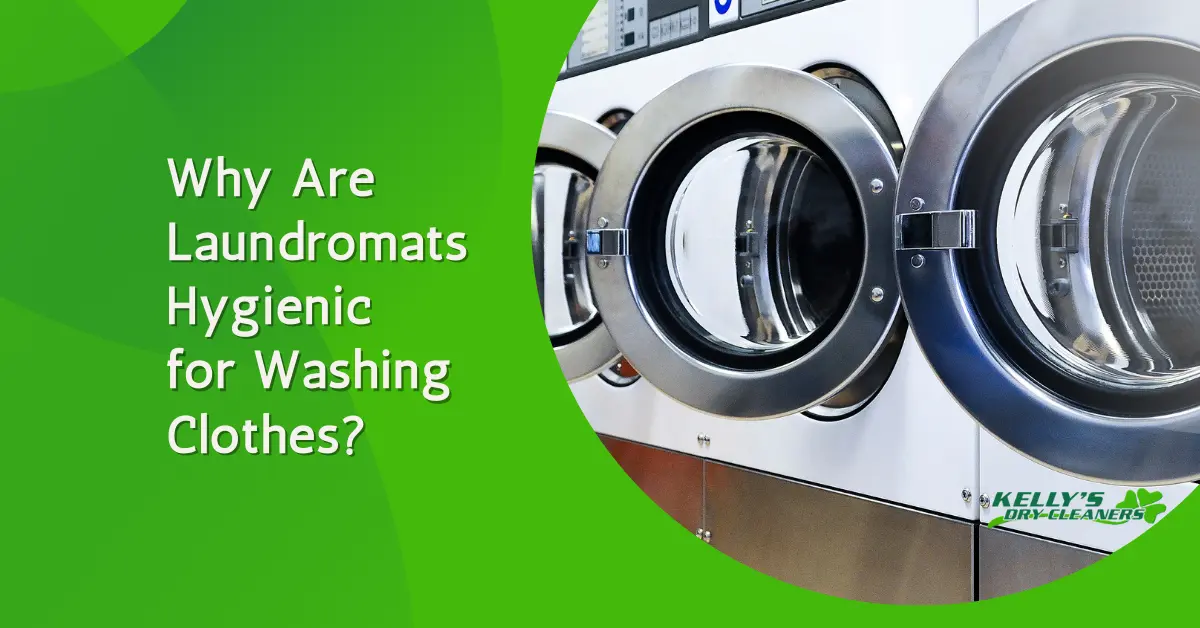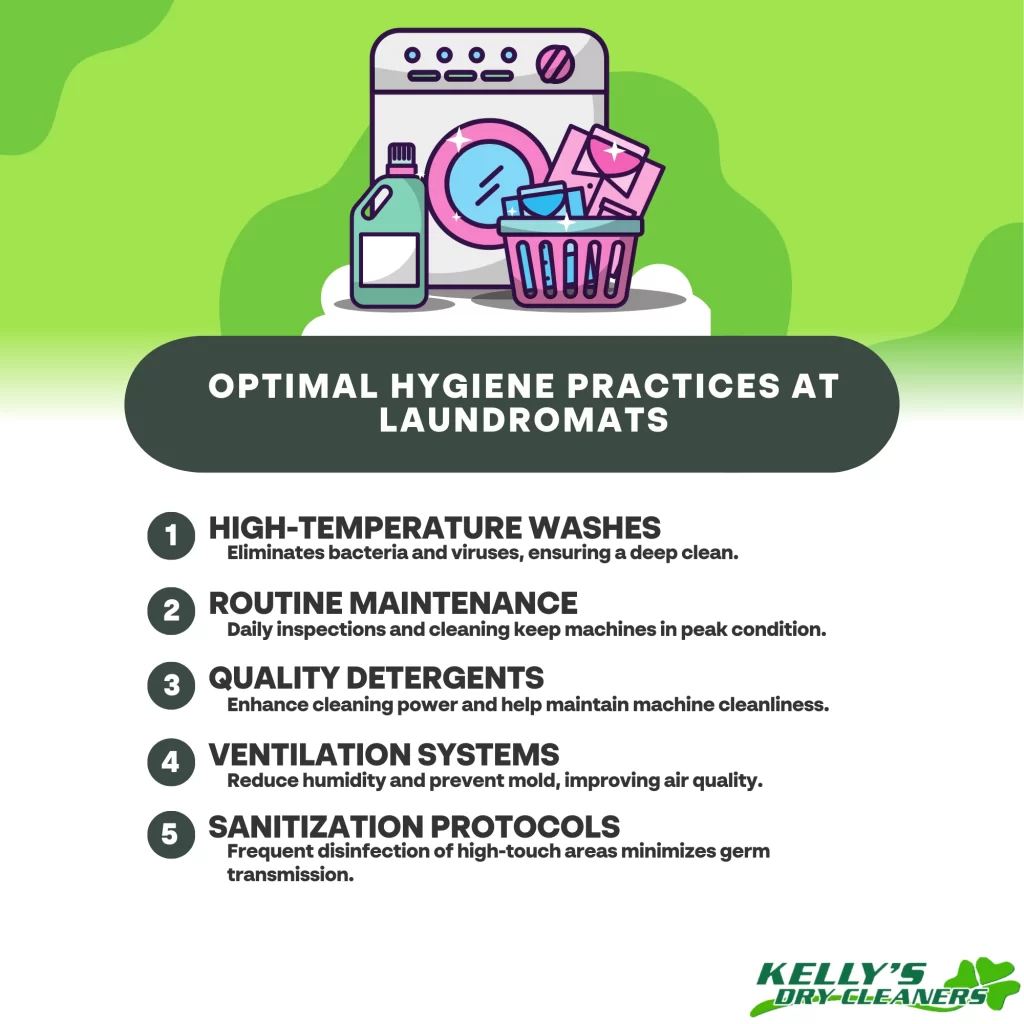Laundromats are hygienic for washing clothes because they use professional-grade washers and dryers designed to meet high hygiene standards. These machines offer high-temperature wash cycles that kill bacteria and viruses, guaranteeing a deep clean. Regular maintenance and sanitization routines keep the equipment and facility spotless and germ-free. Quality detergents improve the cleaning power of these machines. Effective ventilation systems minimize mold growth and enhance air quality. By following these strict protocols, laundromats provide a reliable option for maintaining the cleanliness of your laundry. Interested in more details about how laundromats achieve this level of hygiene?
Key Takeaways
- Commercial-grade machines with high-temperature wash cycles effectively eliminate bacteria, viruses, and fungi.
- Quality detergents penetrate deep into fabrics, ensuring thorough cleaning and sanitization.
- Regular maintenance and equipment inspections maintain hygiene and ensure optimal machine performance.
- Daily cleaning routines and disinfecting high-touch surfaces minimize germ transmission.
- Effective ventilation reduces humidity and airborne contaminants, enhancing overall cleanliness.
Professional-Grade Equipment
When it comes to maintaining ideal hygiene standards in laundromats, investing in professional-grade equipment is indispensable. You might wonder, are laundromats sanitary? The answer largely depends on the quality and type of machines being used. Professional-grade washers and dryers are designed to handle heavy loads and frequent use, guaranteeing thorough cleaning and sanitization.
Are public washing machines clean? High-quality commercial machines often come with advanced features like high-temperature wash cycles&text=This%20also%20generally%20results%20in,to%20the%20additional%20heating%20time.) and specialized sanitizing settings, which help in eliminating bacteria, viruses, and stubborn stains. These machines are built to meet stringent hygiene standards, making them far superior to their household counterparts.
Do laundromats clean their machines? Yes, and with professional-grade equipment, the process is more efficient and effective. These machines are easier to maintain and clean, reducing the likelihood of residue buildup and cross-contamination. Built-in self-cleaning functions and robust construction further guarantee that the machines remain sanitary between uses.
Regular Maintenance Schedules
To maintain a hygienic laundromat, you’ll need to implement frequent cleaning routines and regular equipment inspections. Cleaning schedules should include daily, weekly, and monthly tasks to guarantee all areas and machines are sanitized. Additionally, consistent equipment inspections can help identify and address any potential issues before they impact your service quality.
Frequent Cleaning Routines
Despite the temptation to overlook it, a meticulous and consistent cleaning routine is essential for maintaining a hygienic and welcoming laundromat environment. You might wonder, are laundromats sanitary, or are public washing machines clean? The answer largely depends on these frequent cleaning routines. Laundromats clean their machines regularly to guarantee they meet health and safety standards. This involves daily wipe-downs of washer and dryer surfaces, removing any detergent or fabric softener residues, and verifying lint traps are emptied to prevent buildup.
Additionally, floors and folding areas are swept and sanitized multiple times a day to remove any dirt or bacteria tracked in by patrons. High-touch surfaces, such as door handles, payment kiosks, and seating areas, are also disinfected frequently to minimize the risk of germ transmission. Staff are trained to follow strict cleaning protocols, making sure every machine and surface is attended to systematically.
These diligent practices address concerns about whether public washing machines are clean, providing peace of mind to users. A well-maintained laundromat not only keeps the environment sanitary but also extends the lifespan of the equipment, promoting efficient operation for all patrons.
Equipment Inspections
While a stringent cleaning routine forms the backbone of a hygienic laundromat, regular equipment inspections guarantee everything runs smoothly and safely. You might wonder, are laundromats clean and do laundromats clean their machines frequently? The answer lies not just in the cleaning routines but also in the rigorous maintenance schedules that confirm the machinery is in excellent condition, contributing to a sanitary environment.
Laundromat owners often follow a detailed maintenance checklist that includes inspecting hoses, checking for leaks, and testing water temperatures. These inspections confirm that machines operate efficiently and reduce the risk of bacterial buildup. When laundromats clean their machines, the inspections verify that detergents and sanitizers are dispensed correctly, confirming that each wash cycle meets hygieen standards.
Regular equipment inspections also identify wear and tear early, preventing potential breakdowns that could compromise cleanliness. Technicians often calibrate machines to maintain peak performance, confirming that water levels and agitation cycles are just right. This attention to detail reassures you that laundromats are sanitary, providing a reliable and hygienic service. By adhering to these practices, laundromats maintain an environment where you can confidently clean your clothes.
High-Temperature Wash Cycles
When you use high-temperature wash cycles&text=This%20also%20generally%20results%20in,to%20the%20additional%20heating%20time.), you’re greatly enhancing germ elimination efficiency. These cycles penetrate deep into fabrics, guaranteeing a thorough cleaning that cold or warm washes can’t achieve. For ideal hygiene, always consider the recommended temperatures for different materials to balance fabric care and cleanliness.
Germ Elimination Efficiency
High-temperature wash cycles are crucial for achieving ideal germ elimination in laundromats. You might wonder, are laundromats sanitary, and are public washing machines clean? The answer lies in the efficiency of these high-temperature cycles. When water reaches temperatures of 140°F (60°C) or higher, it becomes highly effective at killing bacteria, viruses, and fungi that cling to your clothes. This level of heat disrupts the cellular structures of pathogens, rendering them inactive and guaranteeing that your garments come out hygienically clean.
Laundromats are designed to meet stringent health and safety standards, which is why they incorporate machines capable of maintaining these high temperatures consistently. Are laundromats clean? Absolutely, especially when you factor in the regular maintenance and cleaning protocols they follow. The high-temperature wash cycles&text=This%20also%20generally%20results%20in,to%20the%20additional%20heating%20time.) in public washing machines don’t just sanitize your clothes; they also help keep the machines themselves free from residual pathogens that could otherwise accumulate over time.
Deep Fabric Penetration
Achieving proper deep fabric penetration during wash cycles guarantees that even the innermost fibers of your clothes are thoroughly sanitized. High-temperature wash cycles&text=This%20also%20generally%20results%20in,to%20the%20additional%20heating%20time.), typically available at laundromats, are vital for this process. These machines often reach temperatures that home washers can’t, guaranteeing a more effective kill rate for bacteria, viruses, and other pathogens. So, if you’re wondering, are laundromats sanitary? The answer is a resounding yes, thanks to this feature.
Moreover, when considering are public washing machines clean, it’s important to note that high-temperature cycles dissolve and remove stubborn residues, including sweat, oils, and stains embedded deep within fabric layers. This level of cleanliness is difficult to achieve with lower temperature cycles or less advanced home washing machines.
The efficiency of high-temperature cycles in laundromats also addresses concerns about are laundromats clean. These machines are built to handle larger loads and more frequent use, which means they are designed with superior hygiene standards. Regular maintenance and professional-grade detergents further improve their sanitizing power. To summarize, laundromats’ high-temperature wash cycles provide an unmatched level of deep fabric penetration, guaranteeing your clothes come out clean and thoroughly sanitized.
Use of Quality Detergents
A fundamental aspect of maintaining hygiene in laundromats is the use of quality detergents. When you question, “Are laundromats sanitary?” you’ll find that the answer often hinges on the detergents used. Quality detergents are formulated to effectively break down and remove dirt, bacteria, and viruses from fabrics. They contain enzymes and surfactants that penetrate deep into fibers, guaranteeing a thorough clean. This guarantees that public washing machines, which see a high turnover of users, can consistently deliver hygienic results.
It’s also essential to understand how laundromats maintain their machines. You might wonder, “Do laundromats clean their machines?” The answer is yes, but the efficiency of this process is greatly boosted by the detergents used. High-quality detergents help keep the internal components of the machines cleaner, reducing residue build-up and microbial contamination. This continuous cleaning action means that the machines themselves stay more sanitary between scheduled maintenance.
When pondering, “Are public washing machines clean?” remember that the detergents play a key role. Using top-tier detergents guarantees that each wash cycle not only cleans your clothes but also contributes to the overall hygiene of the laundromat environment.
In-House Sanitization Practices
When it comes to in-house sanitization practices, you should know that laundromats employ a thorough approach to guarantee the cleanliness and hygiene of their facilities. Are laundromats sanitary? Absolutely, and this is due to their rigorous cleaning protocols. Daily cleaning routines ascertain that all surfaces, including folding tables, countertops, and floors, are disinfected multiple times. High-touch areas like door handles and payment kiosks receive extra attention to minimize the risk of germ transmission.
Do laundromats clean their machines? Yes, they do. Laundromat staff regularly sanitize the interior and exterior of washing machines and dryers. They use specialized cleaning agents designed to eliminate bacteria and mold, confirming that each machine is ready for safe use. Lint traps and detergent dispensers are also meticulously cleaned to prevent buildup and maintain peak machine performance.
Are laundromats clean? The answer is a resounding yes. Many laundromats even use signage to inform customers of their sanitation practices, building trust and guaranteeing peace of mind. By adhering to strict in-house sanitization practices, laundromats maintain an environment where you can confidently wash and dry your clothes without worrying about hygiene.
Customer Cleanliness Guidelines
Maintaining personal hygiene while using laundromats is just as vital as the facility’s in-house sanitization efforts. To guarantee that laundromats are sanitary, start by handling your dirty laundry carefully. Use a designated laundry bag to transport your clothes, and avoid placing them on communal surfaces.
Before using a washing machine, check if it’s clean. Are public washing machines clean? Often they are, but a quick wipe with a disinfectant wipe can add an extra layer of protection. Don’t forget to clean your hands after loading your clothes into the machine.
While waiting, avoid touching your face and try to use hand sanitizer regularly. Once your laundry is done, use a clean bag or container to store your freshly washed clothes. This guarantees they remain uncontaminated until you reach home.
Are laundromats clean? Generally, yes, but your proactive measures considerably contribute to maintaining this cleanliness. By adhering to these guidelines, you’re not only protecting yourself but also helping to maintain the overall hygiene of the facility. Remember, your actions play a vital role in guaranteeing that laundromats remain a sanitary place for everyone.
Air Circulation and Ventilation
Effective air circulation and ventilation in laundromats are vital for guaranteeing a clean and safe environment. Proper airflow helps to minimize the accumulation of humidity, which can otherwise promote the growth of mold and mildew. This is particularly important in laundromats where water and steam are constantly present. By establishing robust ventilation systems, laundromats can effectively reduce the risk of unpleasant odors and airborne contaminants, contributing to a more sanitary space.
You might wonder, are laundromats sanitary given the high turnover of users and machines? Air circulation plays a significant role here. Well-ventilated laundromats facilitate the rapid drying of clothes, helping to prevent bacterial growth that can occur in damp conditions. High-efficiency particulate air (HEPA) filters in modern ventilation systems further improve cleanliness by trapping dust, pollen, and other potential allergens.
Addressing concerns about whether laundromats are clean or are laundromats dirty, the answer largely depends on maintenance practices. However, an important element that tilts the balance towards cleanliness is effective ventilation. Properly maintained systems guarantee that the air is continuously refreshed and contaminants are expelled, creating a healthier environment for all users.
Conclusion
So, when you wash your clothes at a laundromat, you’re not just cleaning them—you’re practically sending them to a sanitizing fortress. With professional-grade equipment, rigorous maintenance, scorching hot wash cycles, high-quality detergents, and strict cleanliness guidelines, laundromats guarantee your clothes come out cleaner than ever. Plus, excellent air circulation and ventilation keep the environment fresh. Trust these expert practices, and you’ll never have to worry about hygiene in your laundry routine again.




